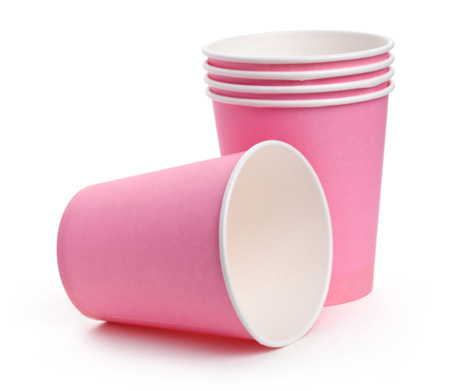Activity: Paper Cup Challenge
(Activity courtesy LearnNC, the Kenan Fellow Program, and Erin Denniston) Level: grades 5 – 8. Time required: One class period of 45–60 minutes. Group Size: 3 to 4 students.
 Overview
Overview
In this activity, students in grades 5 through 8 are challenged to redesign the classic paper cup so that no tape, glue, or staples are necessary, reducing production costs and the cost of individual paper cups. Each pair of students will be given a stack of paper to design a new paper container that can hold water for a short period of time.
Learning Objectives
Students will:
- Design a solution to reduce the cost of producing a paper cup but stay within given restraints
- Implement and evaluate the solution
- Accurately record and communicate observations
Standards
North Carolina Science, Grade 6 (2005)
Goal 2: The learner will demonstrate an understanding of technological design.
Objective 2.03: Evaluate technological designs for:
- Application of scientific principles.
- Risks and benefits.
- Constraints of design.
- Consistent testing protocols.
Materials
Per class:
- 2–3 large basins filled with water
- 2 measuring cups per basin
- several towels
Per team of two students:
- 5–10 pieces of 8 1/2″ × 11″ paper (recycled if possible)
- 1 small towel
- 1 pencil
- 1 design sheet
- Paper cup Data Sheet
Procedure
Introduction and Design Process
1. Set out the basins and water at a testing station, in the center of the room if possible. Place the measuring cups next to the basins. Place several towels at the testing station.
2. Introduce the activity to the students by explaining that their challenge will be to redesign the classic paper cup so that no tape, glue, or staples are necessary, producing a proto-type for a cup that could lower production and product costs.
In addition, their paper container must meet these criteria:
- The container must be made from only one sheet of paper, 8 1/2″ × 11″ in size.
- The paper may not be cut, torn, taped, glued, or stapled. It can be folded in any way.
- It must hold as much water as possible.
- It must be sturdy.
3. Divide the class into teams of 3 to four students. Hand out the Paper cup Data Sheet and other materials needed by each group.
4. Discuss the issue of timing with students and come up with a method that everyone agrees will work. Timers are impractical for the activity because the cup needs to move from person to person. Establish a method for counting to thirty seconds (one Mississippi, two Mississippi…) that everyone will use to ensure the cups are tested under fair conditions. To ensure that everyone understands the testing process, below, the teacher might give a demonstration, with the help of several students.
5. Allow students ample time to design and construct their paper container, encouraging experimentation and testing.
Testing: Does It Hold Water?
As teams are ready, they can bring their best designs to the testing station; large classes may need to share the basins. Depending upon the time allotted for this activity and their efficiency, teams can run 3 to 6 tests. Remind students to record the outcome of each test on their sheets.
1. To test a finished design, one member should hold the container over the basin while the other pours water into the cup.
2. The first member must hold the cup for thirty seconds and then pass it to another team member. When the count starts, no additional water may added to the cup. The second team member must also hold it for thirty seconds.
3. After a minute is up, the team should pour the remaining water into the measuring cup and record the results on their sheet. The team should make a drawing of their design next to their results.
4. Teams may create as many as six designs; each trial should be recorded on the data sheet.
5. It time permits, have each team demonstrate its best design for the rest of the class, encouraging discussion of the different solutions, as well as failures and discoveries during the design and testing process.
Assessment
Discuss the results of the tests. How much water did the best cup hold? How did the designs of the different teams compare and differ? Which were the most unusual or creative designs? One that seems most marketable? What would students do differently if they were to refine their design?
Extension
Ask students to look for paper cup designs over the next week, reporting back on designs they find that are particularly ingenious — or illogical. If possible, have them bring in examples to examine and compare.
Filed under: Class Activities, Grades 6-8, Grades K-5
Tags: Engineering Design, grades 5-8








